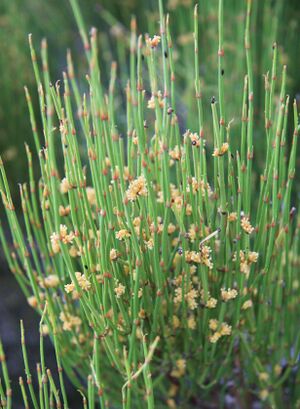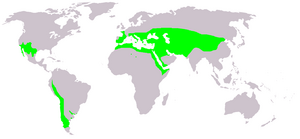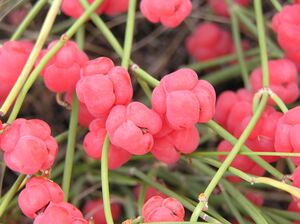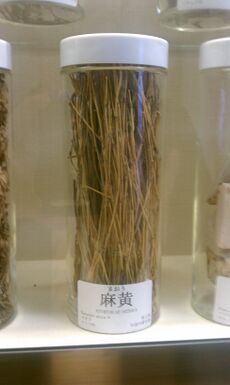علندي
| علندي | |
|---|---|

| |
| Ephedra viridis | |
| التصنيف العلمي | |
| أصنوفة غير معروفة (أصلحها): | Ephedra |
| Type species | |
| Ephedra distachya | |

| |
| Global range of Ephedra | |
| Synonyms[2] | |
| |
علند/علندي/علد Ephedra هو جنس من gymnosperm shrubs. The various species of Ephedra are widespread in many arid regions of the world, ranging across southwestern North America, southern Europe, northern Africa, southwest and central Asia, northern China and western South America.[2] It is the only extant genus in its family, Ephedraceae, and order, Ephedrales, and one of the three living members of the division Gnetophyta alongside Gnetum and Welwitschia.
In temperate climates, most Ephedra species grow on shores or in sandy soils with direct sun exposure. Common names in English include joint-pine, jointfir, Mormon-tea or Brigham tea. The Chinese name for Ephedra species is mahuang (الصينية المبسطة: 麻黄; الصينية التقليدية: 麻黃; پنين: máhuáng; Wade–Giles: ma-huang; lit. 'hemp yellow'). Ephedra is the origin of the name of the stimulant ephedrine, which the plants contain in significant concentration.



الوصف
The family Ephedraceae, of which Ephedra is the only extant genus, are gymnosperms, and generally shrubs, sometimes clambering vines, and rarely, small trees. Members of the genus frequently spread by the use of rhizomes.[3]
The stems are green and photosynthetic.[4] The leaves are opposite or whorled. The scalelike leaves fuse into a sheath at the base and this often sheds soon after development. There are no resin canals.[3]
The plants are mostly dioecious, with the pollen strobili in whorls of 1–10, each consisting of a series of decussate[5] bracts. The pollen is furrowed. The female strobili also occur in whorls, with bracts which fuse around a single ovule. Fleshy bracts are white (such as in Ephedra frustillata) or red. There are generally 1–2 yellow to dark brown seeds per strobilus.[3]
التبويب
The genus Ephedra was first described in 1753 by Carl Linnaeus,[6][7][8] and the type species is Ephedra distachya.[7] The family, Ephedraceae, was first described in 1829 by Dumortier.[6][9]
التاريخ التطوري
The oldest known members of the genus are from the Early Cretaceous around 125 million years ago, with records being known from the Aptian-Albian of Argentina,[10] China,[11] Portugal and the United States.[12] The fossil record of Ephedra outside of pollen disappears after the Early Cretaceous.[13] Molecular clock estimates have suggested that last common ancestor of living Ephedra species lived much more recently, during the Early Oligocene around 30 million years ago.[14] However, pollen modified from the ancestral condition of the genus with branched pseudosulci (grooves), which evolved in parallel in the living North American and Asian lineages is known from the Late Cretaceous, suggesting that the last common ancestor is at least this old.[13]
الأنواع
| Phylogeny of Ephedra[15][16] | ||||||||||||||||||||||||||||||||||||||||||||||||||||||||||||||||||||||||||||||||||||||||||||||||||||||||||||||||||||||||||||||||||||||||||||||||||||||||||||||||||||||||||||||||||||||||||||||||||||||||||||||||||||||||||||||||||||||||||||||||||||||||||||||||||||||||||||||||||||||||||
|
|
اعتبارا من يونيو 2021[تحديث], Plants of the World Online accepted the following species:[17]
- Ephedra alata Decne. – North Africa, Arabian Peninsula
- Ephedra altissima Desf. non-Bové (1834), non-Delile (1813), non-Buch (1828) (High-climbing jointfir) – North Africa, Canary Islands
- Ephedra americana Humb. & Bonpl. ex Willd. – Bolivia, Ecuador, Peru, Argentina, Chile
- Ephedra antisyphilitica Berland ex C.A.Mey. – Clapweed, Erect Ephedra – Texas, Oklahoma, New Mexico, Nuevo León, Coahuila, Chihuahua
- Ephedra aphylla Forssk. – eastern Mediterranean from Libya and Cyprus to the Persian Gulf
- Ephedra × arenicola H.C.Cutler – Arizona, Utah (hybrid, E. cutleri × E. torreyana)
- Ephedra aspera Engelm. ex S.Watson – Boundary Ephedra, Pitamoreal – Texas, New Mexico, Arizona, Utah, Nevada, California, Chihuahua, Durango, Zacatecas, Sinaloa, Sonora, Baja California
- Ephedra aurantiaca Takht. & Pachom. – Caucasus, Kazakhstan, Turkmenistan
- Ephedra aurea Brullo et al.
- Ephedra boelckei F.A.Roig – Argentina
- Ephedra botschantzevii Pachom. – Kazakhstan, Tuva region of Siberia
- Ephedra breana Phil. (frutilla de campo) – Peru, Bolivia, Chile, Argentina
- Ephedra brevifoliata Ghahr. – Iran
- Ephedra californica S.Watson – California Ephedra, California Jointfir – California, western Arizona, Baja California
- Ephedra chengiae Yang & Ferguson
- Ephedra chilensis C.Presl – Pingo-pingo - Chile, Argentina
- Ephedra compacta Rose – widespread in much of Mexico
- Ephedra coryi E.L.Reed (Cory's Ephedra) – Texas, New Mexico
- Ephedra cutleri Peebles – Navajo Ephedra, Cutler's Ephedra, Cutler Mormon-tea, Cutler's Jointfir – Colorado, Utah, Arizona, New Mexico, Wyoming
- Ephedra dahurica Turcz. – Siberia, Mongolia
- Ephedra dawuensis Y.Yang – Sichuan
- Ephedra distachya L. – Joint-pine, Jointfir – southern Europe and central Asia from Portugal to Kazakhstan
- Ephedra × eleutherolepis V.A.Nikitin – Tajikistan (hybrid E. intermedia × E. strobilacea)
- Ephedra equisetina Bunge – Ma huang – Caucasus, Central Asia, Siberia, Mongolia, Gansu, Hebei, Inner Mongolia, Ningxia, Qinghai, Shanxi, Xinjiang
- Ephedra fasciculata A.Nelson – Arizona Ephedra, Arizona Jointfir, Desert Mormon-tea – Arizona, California, Nevada, Utah
- Ephedra fedtschenkoae Paulsen – Central Asia, Siberia, Mongolia, Xinjiang
- Ephedra foeminea Forssk. – North Africa, Somalia, Balkans, Italy, Middle East; naturalized in Santa Barbara County of California
- Ephedra foliata Boiss. ex C.A.Mey. (Shrubby horsetail) – North Africa, Somalia, Middle East, India
- Ephedra fragilis Desf. (joint pine) – Mediterranean, Canary Islands, Madeira
- Ephedra frustillata Miers – Patagonian Ephedra – Chile, Argentina
- Ephedra funerea Coville & C.V.Morton – Death Valley Ephedra, Death Valley Jointfir – California, Arizona, Nevada
- Ephedra gerardiana Wall. ex Klotzsch & Garcke – Gerard's Jointfir, Shan Ling Ma Huang – Himalayas, Tibet, Yunnan, Siberia, Central Asia
- Ephedra gracilis Phil. ex Stapf
- Ephedra holoptera Riedl – Iran
- Ephedra intermedia Schrenk & C.A.Mey. (Zhong Ma Huang) – China, Siberia, Central Asia, Himalayas, Iran, Pakistan
- Ephedra kardangensis P.Sharma & P.L.Uniyal – western Himalayas
- Ephedra khurikensis P.Sharma & P.L.Uniyal – western Himalayas
- Ephedra laristanica Assadi – Iran
- Ephedra likiangensis Florin – Guizhou, Sichuan, Tibet, Yunnan
- Ephedra lomatolepis Schrenk – Kazakhstan, Tuva region of Siberia
- Ephedra major Host – Mediterranean, Middle East, Central Asia; from Canary Islands to Kashmir
- Ephedra milleri Freitag & Maier-St. – Oman, Yemen
- Ephedra minuta Florin – Qinghai, Sichuan
- Ephedra monosperma J.G.Gmel. ex C.A.Mey. (dan zi ma huang) – Siberia, Mongolia, much of China including Tibet and Xinjiang
- Ephedra multiflora Phil. ex Stapf – Chile, Argentina
- Ephedra nevadensis S.Watson – Nevada Ephedra, Nevada Jointfir, Nevada Mormon-tea – Baja California, California, Arizona, Nevada, Utah, Oregon
- Ephedra ochreata Miers – Argentina
- Ephedra oxyphylla Riedl – Afghanistan
- Ephedra pachyclada Boiss. – Middle East from Sinai and Yemen to Pakistan
- Ephedra pangiensis Rita Singh & P.Sharma
- Ephedra pedunculata Engelm. ex S.Watson – Vine Ephedra, Vine Jointfir – Texas, Chihuahua, Coahuila, Durango, San Luis Potosí, Nuevo León, Zacatecas
- Ephedra pentandra Pachom. – Iran
- Ephedra procera Fisch. & C.A.Mey. − Iran, Caucasus
- Ephedra przewalskii Stapf – Central Asia, Mongolia, Pakistan, Gansu, Inner Mongolia, Ningxia, Qinghai, Tibet
- Ephedra pseudodistachya Pachom. – Siberia, Mongolia
- Ephedra regeliana Florin – Xi Zi Ma Huang – Central Asia, Siberia, Pakistan, Xinjiang
- Ephedra rhytidosperma Pachom., syn. E. lepidosperma C.Y.Cheng – Gansu, Inner Mongolia, Ningxia, Mongolia
- Ephedra rituensis Y.Yang, D.Z.Fu & G.H.Zhu – Qinghai, Xinjiang, Tibet
- Ephedra rupestris Benth. – Ecuador, Peru, Bolivia, Argentina
- Ephedra sarcocarpa Aitch. & Hemsl. – Pakistan, Afghanistan
- Ephedra saxatilis (Stapf) Royle ex Florin
- Ephedra sinica Stapf – Cao Ma Huang, Chinese ephedra – Mongolia, Siberia, Primorye, Manchuria
- Ephedra somalensis Freitag & Maier-St. – Somalia, Eritrea
- Ephedra stipitata Biswas & Rita Singh
- Ephedra strobilacea Bunge – Iran, Central Asia
- Ephedra strongylensis Brullo et al.
- Ephedra sumlingensis P.Sharma & P.L.Uniyal – western Himalayas
- Ephedra tilhoana Maire – Chad
- Ephedra torreyana S.Watson – Torrey's Ephedra, Torrey's Jointfir, Torrey's Mormon-tea, Cañutillo – Nevada, Utah, Colorado, Arizona, New Mexico, Texas, Chihuahua
- Ephedra transitoria Riedl – Iraq, Syria, Palestine, Saudi Arabia
- Ephedra triandra Tul. − Bolivia, Argentina
- Ephedra trifurca Torrey ex S.Watson – Longleaf Ephedra, Longleaf Jointfir, Longleaf Mormon-tea, Popotilla, Teposote – California, Arizona, New Mexico, Texas, Chihuahua, Sonora, Baja California
- Ephedra trifurcata Zöllner
- Ephedra tweedieana C.A.Mey. – Brazil, Argentina, Uruguay
- Ephedra viridis Coville – Green Ephedra, Green Mormon-tea – California, Nevada, Utah, Arizona, New Mexico, Colorado, Wyoming, South Dakota, Oregon
- Ephedra vvedenskyi Pachom. – Iran, Caucasus, Turkmenistan
- Ephedra yangthangensis Prabha Sharma & Rita Singh – Yangthang to Ka, Leo, Nako, Chango, Chulling, Sumdo, Hoorling and Lira of Kinnaur district of Himachal Pradesh[18]
Distribution
The genus is found worldwide, in desert regions, but not in Australia.[3]
Ecology

Ephedraceae are adapted to extremely arid regions, growing often in high sunny habitats, and occur as high as 4000 m above sea level in both the Andes and the Himalayas.[3] They make up a significant part of the North American Great Basin sage brush ecosystem.
Drug and supplement uses

The Ephedra alkaloids, ephedrine and pseudoephedrine – constituents of E. sinica and other members of the genus – have sympathomimetic and decongestant qualities,[19] and have been used as dietary supplements, mainly for weight loss.[20] The drug ephedrine is used to prevent low blood pressure during spinal anesthesia.[19]
In the United States, ephedra supplements were banned from the market in the early 21st century due to serious safety risks.[20] Plants of the genus Ephedra, including E. sinica and others, were used in traditional medicine for treating headache and respiratory infections, but there is no scientific evidence they are effective or safe for these purposes.[20]
Ephedra has also had a role as a precursor in the clandestine manufacture of methamphetamine.[21]
Adverse effects
Alkaloids obtained from the species of Ephedra used in herbal medicines, which are used to synthetically prepare pseudoephedrine and ephedrine, can cause cardiovascular events.[19] These events have been associated with arrhythmias, palpitations, tachycardia and myocardial infarction.[19] Caffeine consumption in combination with ephedrine has been reported to increase the risk of these cardiovascular events.[19][20]
Economic botany and alkaloid content
The earliest uses of Ephedra species (mahuang) for specific illnesses date back to 5000 BC. Ephedrine and its isomers were isolated in 1881 from Ephedra distachya and characterized by the Japanese organic chemist Nagai Nagayoshi. His work to access Ephedra's active ingredients to isolate a pure pharmaceutical substance led to the systematic production of semi-synthetic derivatives thereof is relevant still today. Three species, Ephedra sinica, Ephedra vulgaris, and to a lesser extent Ephedra equisetina, are commercially grown in Mainland China as a source for natural ephedrines and isomers for use in pharmaceuticals. E. sinica and E. distachya usually carry six optically active phenylethylamines, mostly ephedrine and pseudoephedrine with minor amounts of norephedrine, norpseudoephedrine as well as the three methylated analogs. Reliable information on the total alkaloid content of the crude drug is difficult to obtain. Based on HPLC analyses in industrial settings, the concentrations of total alkaloids in dried Herba Ephedra ranged between 1 and 4%, and in some cases up to 6%.[22]
For a review of the alkaloid distribution in different species of the genus Ephedra see Jian-fang Cui (1991).[23] Other American and European species of Ephedra, e.g. Ephedra nevadensis (Nevada Mormon tea) have not been systematically assayed; based on unpublished field investigations, they contain very low levels (less than 0.1%) or none at all.[24]
See also
References
- ^ Kramer KU, Green PS, Götz E (1990). Kramer KU, Green PS (eds.). The Families and Genera of Vascular Plants, Vol. 1: Pteridophytes and Gymnosperms. Berlin: Springer-Verlag. pp. 379–381. ISBN 3540517944.
- ^ أ ب Kew World Checklist of Selected Plant Families
- ^ أ ب ت ث ج Judd WS, Campbell CS, Kellog EA, Stevens PF, Donoghue MJ (2007). Plant Systematics, a phylogenetic approach (3rd. ed.). Sinauer associates, Inc.
- ^ "Family "Ephedraceae"". Angiosperm Phylogeny Website. Retrieved 5 July 2019.
- ^ Messina A (2014). "VicFlora: Ephedraceae". Victoria, Australia: Royal Botanic Gardens Foundation. Retrieved 5 July 2019.
- ^ أ ب The Gymnosperm database: Ephedra. Retrieved 5 July 2019.
- ^ أ ب Linnaeus C (1753). Species Plantarum. Vol. 2. p. 1040.
- ^ Linnaeus C (1754). Genera plantarum. Vol. 5. p. 462.
- ^ Dumortier BC (1829). Analyse des familles des plantes, avec l'indication des principaux genres qui s'y rattachent. Tournay: J. Casterman aîné. p. 11.
- ^ Puebla GG, Iglesias A, Gómez MA, Prámparo MB (November 2017). "Fossil record of Ephedra in the Lower Cretaceous (Aptian), Argentina". Journal of Plant Research. 130 (6): 975–988. Bibcode:2017JPlR..130..975P. doi:10.1007/s10265-017-0953-1. hdl:11336/59894. PMID 28528483. S2CID 23766815.
- ^ Yang Y, Wang Q (14 January 2013). "The earliest fleshy cone of Ephedra from the early cretaceous Yixian Formation of northeast China". PLOS ONE. 8 (1): e53652. Bibcode:2013PLoSO...853652Y. doi:10.1371/journal.pone.0053652. PMC 3544918. PMID 23341964.
- ^ Rydin C, Pedersen KR, Crane PR, Friis EM (July 2006). "Former diversity of Ephedra (Gnetales): evidence from Early Cretaceous seeds from Portugal and North America". Annals of Botany. 98 (1): 123–40. doi:10.1093/aob/mcl078. PMC 2803531. PMID 16675607.
- ^ أ ب Bolinder, Kristina; Norbäck Ivarsson, Lena; Humphreys, Aelys M.; Ickert-Bond, Stefanie M.; Han, Fang; Hoorn, Carina; Rydin, Catarina (2 January 2016). "Pollen morphology of Ephedra (Gnetales) and its evolutionary implications". Grana (in الإنجليزية). 55 (1): 24–51. Bibcode:2016Grana..55...24B. doi:10.1080/00173134.2015.1066424. ISSN 0017-3134. S2CID 83696018.
- ^ Ickert-Bond, Stefanie M.; Rydin, Catarina; Renner, Susanne S. (2009). "A fossil-calibrated relaxed clock for Ephedra indicates an Oligocene age for the divergence of Asian and New World clades and Miocene dispersal into South America". Journal of Systematics and Evolution (in الإنجليزية). 47 (5): 444–456. doi:10.1111/j.1759-6831.2009.00053.x. ISSN 1759-6831.
- ^ Stull, Gregory W.; Qu, Xiao-Jian; Parins-Fukuchi, Caroline; Yang, Ying-Ying; Yang, Jun-Bo; Yang, Zhi-Yun; Hu, Yi; Ma, Hong; Soltis, Pamela S.; Soltis, Douglas E.; Li, De-Zhu; Smith, Stephen A.; Yi, Ting-Shuang; et al. (2021). "Gene duplications and phylogenomic conflict underlie major pulses of phenotypic evolution in gymnosperms". Nature Plants. 7 (8): 1015–1025. bioRxiv 10.1101/2021.03.13.435279. doi:10.1038/s41477-021-00964-4. PMID 34282286. S2CID 232282918.
- ^ Stull, Gregory W.; et al. (2021). "main.dated.supermatrix.tree.T9.tre". Figshare. doi:10.6084/m9.figshare.14547354.v1.
{{cite journal}}: Cite journal requires|journal=(help) - ^ "Ephedra Tourn. ex L." Plants of the World Online. Royal Botanic Gardens, Kew. Retrieved 23 June 2021.
- ^ Sharma P, Singh R (December 2016). "Ephedra yangthangensis (Ephedraceae), a new species from Himachal Pradesh, India. Bangladesh". Journal of Plant Taxonomy. 23 (2): 195–8. doi:10.3329/bjpt.v23i2.30850.
- ^ أ ب ت ث ج "Ephedrine". Drugs.com. 9 January 2021. Retrieved 23 June 2021.
- ^ أ ب ت ث "Ephedra". National Center for Complementary and Integrative Health, US National Institutes of Health. 1 July 2020. Retrieved 23 June 2021.
- ^ "Ephedra's Role As a Precursor in the Clandestine Manufacture of Methamphetamine". Journal of Forensic Sciences 40(4), 551-560 (1995). Retrieved 30 Dec 2021.
- ^ Brossi A, ed. (1989). The Alkaloids: Chemistry and Pharmacology. Vol. 35. Academic Press. ISBN 0-12-469535-3.
- ^ Kim HK, Choi YH, Erkelens C, Lefeber AW, Verpoorte R (January 2005). "Metabolic fingerprinting of Ephedra species using 1H-NMR spectroscopy and principal component analysis". Chemical & Pharmaceutical Bulletin. 53 (1): 105–9. doi:10.1002/pca.2800020305. PMID 15635242.
- ^ Hegnauer R. (1962) "Chemotaxonomie der Pflanzen. I". Birkhauser Verlag, Basel; Switzerland, pp. 460–462 as cited in Roman MC (2004). "Determination of ephedrine alkaloids in botanicals and dietary supplements by HPLC-UV: collaborative study". Journal of AOAC International. 87 (1): 1–14. doi:10.1093/jaoac/87.1.1. PMC 2584348. PMID 15084081.
External links
- Ephedra viridis (Plants for a Future Database)
- Usage in Chinese Medicine
- Ephedra fact sheet, NIH National Center for Complementary and Integrative Health
- Ephedrea (Evidence and dosing) Archived 22 سبتمبر 2017 at the Wayback Machine, Mayo Clinic
- Ephedra – Clinical summary and mechanism of action, MSKCC Memorial Sloan Kettering Cancer Center
- Ephedraceae of Mongolia in FloraGREIF Archived 4 أبريل 2016 at the Wayback Machine
- Short description is different from Wikidata
- Automatic taxobox cleanup
- Articles containing simplified Chinese-language text
- Articles containing traditional Chinese-language text
- مقالات فيها عبارات متقادمة منذ يونيو 2021
- جميع المقالات التي فيها عبارات متقادمة
- Articles with hatnote templates targeting a nonexistent page
- Gymnosperm genera
- Ephedraceae
- Medicinal plants
- Soma (drink)
- Plants used in traditional Chinese medicine
- Aptian genus first appearances
- Extant Aptian first appearances